Fret not, dear blog reader. I have your answer.
The September birth month flowers are the aster and the morning glory. Oh yeah, beautiful and meaningful. Good stuff. If you were a reader last year you may remember “Mark September With An Aster-isk”, our friendly reminder blog about the birth month flower of September. You may also remember that September can be quite a headache for my family! With three birthdays on the same day stuff gets really crazy toward the middle of the month.
Mom is great. She’s one of my favorite people in the whole world and I’d be lost without her. That’s a great (and true) sentiment for the card, but you can’t really package that. Oh wait, yes you can! It may not come in a box but a birthday bouquet with aster is a package that she’ll be happy to receive! I’m thinking that showing it off to her friends at work will be fun for her given the type of women she works with. If I can make her day better, why not? So this year I’m sending Mom the gift that she loved last year — asters.
Now the other Virgo in my life is a bit harder. I tend to stop by game stores a lot when shopping for him but I’m pretty tired of staring at electronics. By the time I muster up the courage to go shopping, the last place I want to be is somewhere that will take a lot of time. Plus, I can never remember which games he has so I get a gift card. It’s a little impersonal (or so he said last year) so I don’t want to repeat that experience.
My Love may be brutally honest but he has a point so I’m sending him aster flowers instead. It’s kind of payback for the comment about the gift card. Plus, his daughter loves playing with flowers and dirt and bugs and grass so we’ll have a lot of fun planting morning glory in the backyard. This may not be the ideal way to send birth month flowers of September. Given that not everyone lives in a fairytale world of romance and lollipops, I’m sure I’m not the only one who finds this a funny alternative.
Regardless of your intent, you really can’t go wrong with birth month flowers. They’re just too cool! Plus they’re really unique so you don’t have to worry about someone copying your idea. It’s all yours. Be your own with aster and morning glory this September.


 Find Your
Find Your 


 Consider the enchanting
Consider the enchanting  The ethereal, light and airy
The ethereal, light and airy  It just wouldn’t be spring without masses of tiny
It just wouldn’t be spring without masses of tiny  Star-shaped, pale blue
Star-shaped, pale blue  In my humble opinion, a garden without
In my humble opinion, a garden without  The buds of the herbaceous perennial
The buds of the herbaceous perennial  Best planted in large groups for maximum visual impact,
Best planted in large groups for maximum visual impact,  This
This  And finally, we can’t forget the diminutive
And finally, we can’t forget the diminutive